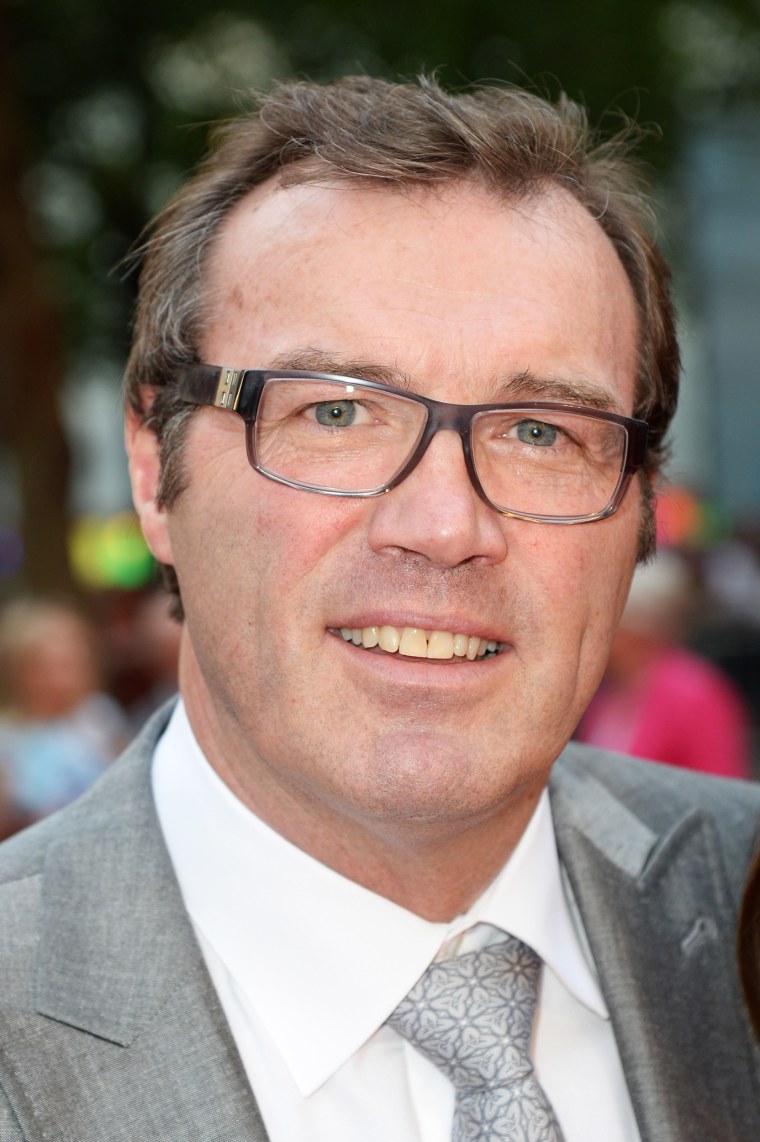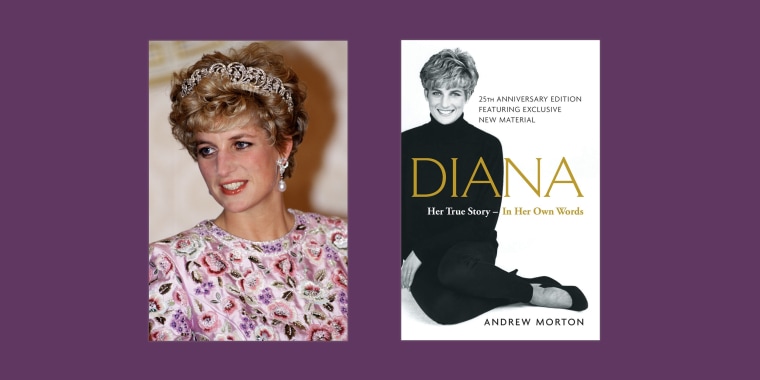This story discusses suicide. If you or someone you know is at risk of suicide please call the U.S. National Suicide Prevention Lifeline at 800-273-8255, text HOME to 741741 or go to SpeakingOfSuicide.com/resources for additional resources.
Princess Diana had a story that everyone wanted to hear — and no one could tell it better than she could. In the decade since marrying Prince Charles, heir to the British throne, the royal had skyrocketed to global fame, and had also experienced the difficulties of being part of her new family.
The title of Andrew Morton’s bombshell book “Diana: Her True Story In Her Own Words" is literal.
As Season Five of “The Crown” shows, Diana contributed directly to the creation of the book — though that fact didn’t emerge until after her death in 1997 at the age of 36.
When the book came out in 1992, it was initially published under the title, "Diana: Her True Story," and became a bestseller.
The book went into detail about the royal's life before becoming Princess of Wales and gave a private perspective on Diana’s public life: Her unhappy marriage, her husband’s relationship with Camilla Parker Bowles and Diana’s struggles with an eating disorder.
During the initial publication, Morton and Diana alike denied she was part of the book’s sourcing, per Frontline. Morton said he was accused of lying, recalling the experience in a 2017 interview with the Belfast Telegraph.
“I knew it was all true, because the words came out of Diana’s own mouth. But it was frustrating that I was getting lambasted. I thought journalists might have got the nods and winks in the text about how I got the quotes from Diana. But most of them were asking how dare I write it,” he said.
In 1997, Morton revealed who, exactly, had been sharing all those details: Diana herself. A revised version, entitled "Diana: Her True Story In Her Own Words," contained an 18,000 word transcript of the tapes Diana recorded and passed along to Morton.
“The story is based on a lengthy, tape-recorded interview with Diana, supplemented by her family and friends,” Morton wrote in the foreword of the memoir’s revised version, published in 1997.
This methodology sets the book apart from the many other books written about Diana. "This his biography is unique in that the story contained in its pages would never have appeared had it not been for the wholehearted cooperation of Diana, the late Princess of Wales,” Morton wrote.
Read on for more about the creation of the memoir — and the fallout of going public.
The biography was Diana’s way of sharing her story
Speaking to NBC News in 2004, Dr. James Colthust — who acted as a go-between for Morton and the princess — shared that the book was Diana’s idea.
According to Colthurst, who met Diana during a skiing trip when she was 19, writing the book was a way to share her side of the story.
“I think it was a gradual realization by her that she needed to have some control over what was said … and that wasn‘t going to be possible in a newspaper. It was better, in fact, to do that through a book. And really that was a decision that she gradually came to over some months,” Colthurst said.
In the introduction to the revised version book, Morton wrote that, amid her crumbling marriage, Diana was in a “genuine predicament.”
Her task? “To give the public an insight to her side of the story while untangling the legal, emotional and constitutional knots that kept her tethered to the monarchy.”
Diana felt herself a “prisoner trapped inside a bitterly unfulfilled marriage,” and felt “shackled to a whole unrealistic public image of her royal life” and to “an unsympathetic royal system.”
For Diana, a book was the solution. Charles later contributed to his own book. He admitted to infidelity in a 1994 interview with Jonathan Dimbleby, who later wrote a book with his cooperation.
The princess hand-picked Morton for the job, not the other way around
In “The Crown,” Diana gets wind of a book by Morton, and decides to contribute. But historical accounts say that Diana picked Morton herself to write the book.
Colthurst explained to NBC, “He had done some books on her, and she felt they were sympathetic, although they were quite lightweight in the subject matter.”
Diana felt that, since Morton was young — he was about 39 in 1992 — he might be more “sympathetic” to her.
A 1997 story in the New York Times backs up Colthurst’s account: “Mr. Morton said he was asked to become the conduit for her story after Diana learned he was preparing a biography of her. A friend of hers summoned him to a working-class pub in the northwest London suburb of Ruislip and reported her interest, saying she had been impressed by his fairness in articles and books he had written during his years as the royal correspondent for two national tabloids."

Morton and Diana never met, instead communicating through tapes delivered by James Colthurst
Speaking to NBC, Colthurst explained how the process worked. He would “peddle in” to Kensington Palace with a briefcase, containing Morton’s questions in a briefcase in the bicycle basket.
“Initially, I sat and I read out the questions, but that was too slow for Diana. She snatched the questions away from me and then clipped the microphone on to herself and the tape recorder was on and away she went,” Colthurst said.
Colthurst then delivered the tapes back to Morton. “I was never face-to-face with Diana, so that we could give her deniability,” Morton said in 2017 to the Belfast Telegraph.
The publisher had to be convinced Diana's allegations were real
In the book "The Diana Chronicles," Tina Brown recounted the lengths Diana went to convince publishers her stories were true — especially regarding her marriage.
Morton's publisher Michael O'Mara wanted proof "besides Diana's word" that Camilla Parker Bowles was linked to Charles.
"Diana stole a cache of Camilla's love letters to Charles from the Princes' briefcase at Balmoral and allowed her publishers to peruse them as evidence. The team was instantly persuaded that the affair was real," Brown wrote.
What, exactly, does the book say?
A lot! Below, find some of the revelations.
She recounted their engagement
Diana gave a play-by-pay of how Charles proposed after about 13 meetings.
"He said: ‘Will you marry me?’ and I laughed. I remember thinking: ‘This is a joke’, and I said: ‘Yeah, OK’, and laughed. He was deadly serious. He said: ‘You do realize that one day you will be Queen.’ And a voice said to me inside: ‘You won’t be Queen but you’ll have a tough role.’ So I thought: ‘OK’, so I said: ‘Yes.’ I said: ‘I love you so much, I love you so much.’ He said: ‘Whatever love means.’ He said it then. So I thought that was great! I thought he meant that! And so he ran upstairs and rang his mother."
Diana said her eating disorder began the week after her engagement
Diana pinpointed the exact moment that "triggered" her bulimia.
“It was all very strange, I just felt miserable. My husband put his hand on my waistline and said: ‘Oh, a bit chubby here, aren’t we?’ and that triggered off something in me,” she explained. “And the Camilla thing, I was desperate, desperate. I remember the first time I made myself sick. I was so thrilled because I thought this was the release of tension.”
She spoke to her mental health struggles and suicide attempt
Diana said she when she "threw" herself "down the stairs" during her pregnancy with William: “Charles said I was crying wolf and I said I felt so desperate and I was crying my eyes out and he said: ‘I’m not going to listen. You’re always doing this to me. I’m going riding now.’ So I threw myself down the stairs."
Diana said she attempted suicide a second time.
“I was running around with a lemon knife, one with the serrated edges. I was just so desperate,” Diana recalled, not specifying the date when this occurred. “I knew what was wrong with me but nobody else around me understood me. I needed rest and to be looked after inside my house and for people to understand the torment and anguish going on in my head. It was a desperate cry for help. I’m not spoiled — I just needed to be allowed to adapt to my new position.”
She spoke to the queen about her marriage problems
Diana said she and her mother-in-law had a conversation about her marriage to Charles.
"'I’ll never let you down but I cannot say the same for your son.’ She took it quite well,” Diana recalled telling the queen. “She indicated to me that the reason why our marriage had gone downhill was because Prince Charles was having such a difficult time with my bulimia. She told me that.”
And her confrontation with Camilla
According to the book, Diana confronted Camilla about her relationship with Charles in the '80s.
"I said to Camilla: ‘I’m sorry I’m in the way, I obviously am in the way and it must be hell for both of you, but I do know what is going on. Don’t treat me like an idiot,'" Diana recalled saying.
Diana and Charles separated in 1992
The book was published in June. Months later, in December, the Prince and Princess of Windsor announced their formal separation.
The book has been revised twice since its first publication
After Diana’s death, Morton revealed that Diana was his primary source in an expanded 1997 edition. In 2017, for the 20th anniversary of her death, Morton published another expanded edition taking into account William and Harry’s lives. “I think my book is basically about appreciating and understanding the life of the woman we lost,” Morton told the Belfast Telegraph.
The 2017 documentary contains footage from the tapes
The expanded version, published in 1997, included an 18,000 word transcript of Diana’s tapes. For another immersive look at “her own words,” the 2017 documentary “Diana: In Her Own Words” contains audio footage that Morton used to write his memoir.
